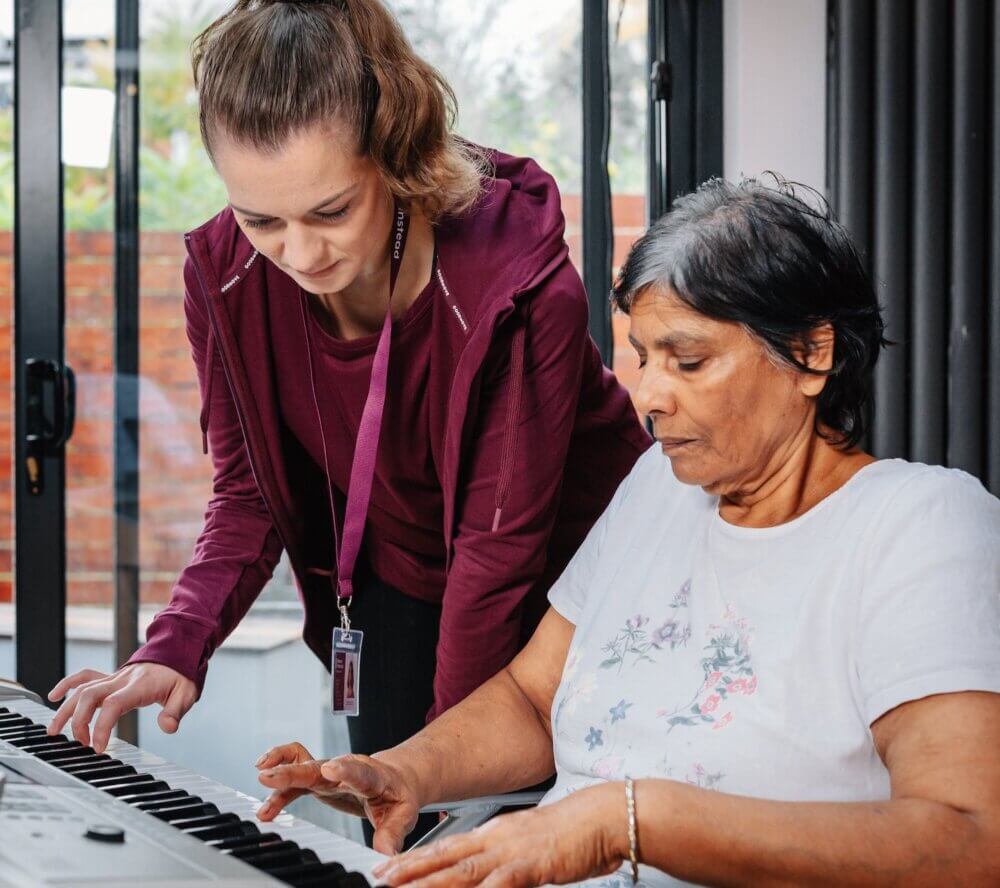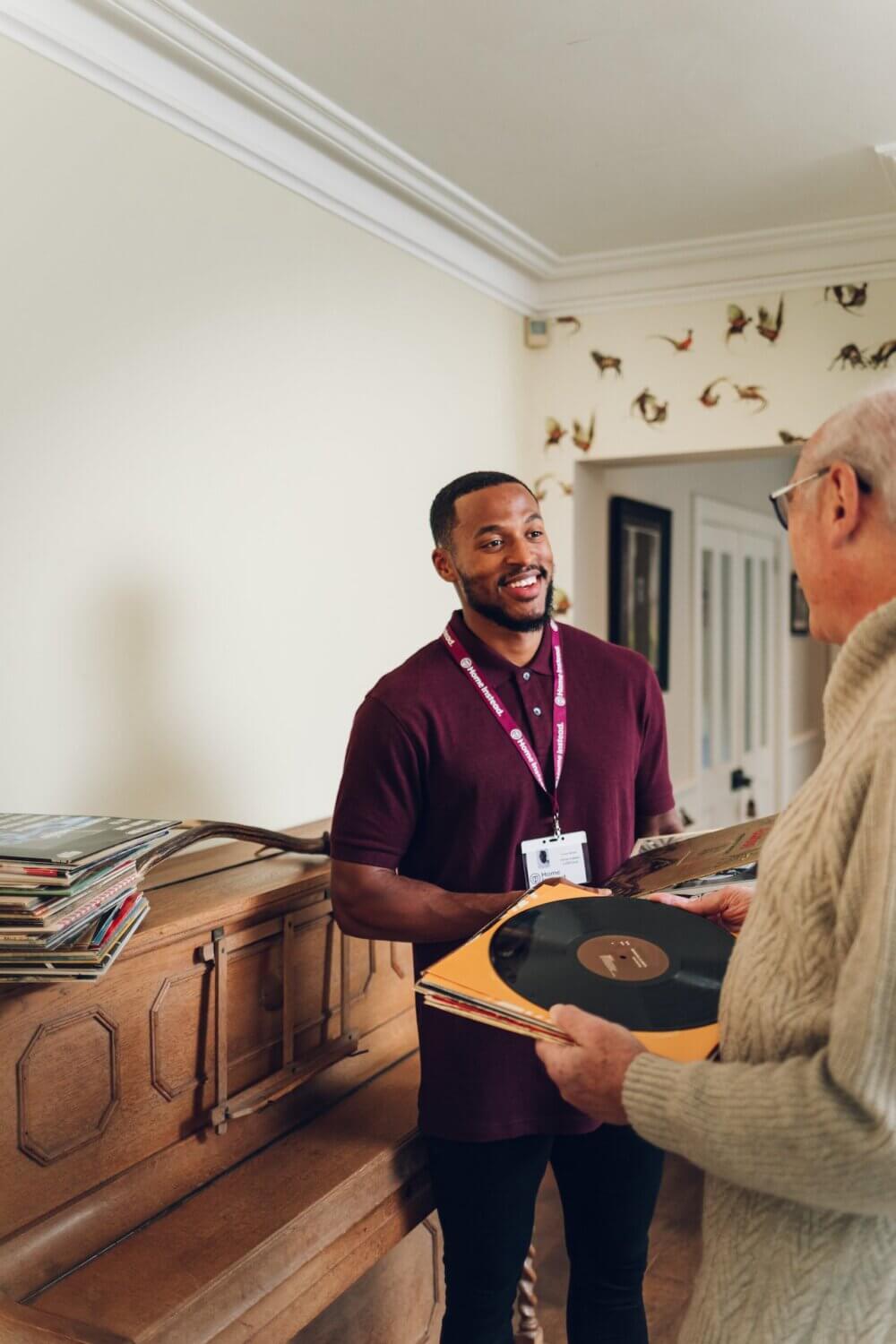Master Active Listening and Empathy for Better Care
At Home Instead Warminster & Gillingham, we recognise the importance of good communication in providing quality care to our clients.

At Home Instead Warminster & Gillingham, we recognise the importance of good communication in providing quality care to our clients. Building rapport and making meaningful connections often begins with finding common ground. Listening plays a key role in this process – not just hearing, but truly understanding what is being said. This blog post explores the art of active and empathetic listening, offering insights, examples, and practical tips to help you improve your communication skills, whether you’re a professional caregiver or looking after a loved one at home.

Understanding the Importance of Listening in Care
Effective communication is fundamental to quality care, building trust, reducing misunderstandings, and significantly improving the overall well-being of those we care for.
Active and empathetic listening goes beyond the processing words; it involves understanding the emotions, needs, and concerns behind those words. This skill is crucial in both professional and personal settings.
Setting aside personal judgments and evaluations to better understand and validate the emotions of others, including one’s own emotions, enhances empathic listening and helps in:
- Building Trust and Rapport: People are more likely to open up and share their true feelings when they feel genuinely heard. This openness is crucial for understanding their needs and providing appropriate care.
- Enhancing Emotional Support: By acknowledging and validating a persons emotions, caregivers can provide better emotional support, which is essential for holistic care.
- Improving Care Outcomes: Understanding the nuances of an individual’s needs and preferences leads to more personalised and effective care plans, ensuring that the care provided is tailored to their unique situation.

What is Active Listening?
Active listening is a technique that requires the listener to fully concentrate, understand, respond, and remember what is being said. It involves being fully present in the conversation and engaging with the speaker on a deeper level. Preparing and practising conversation starters can ease anxiety and promote smoother interactions, making it easier to engage in active listening.
Key Components of Active Listening
- Paying Full Attention: This means putting aside distractions and focusing entirely on the speaker, using eye contact, nodding, and other body language cues to show attentiveness.
- Showing That You’re Listening: Use verbal affirmations like “I see,” “I understand,” or simply “Yes” to show engagement in the conversation. Asking open-ended questions can further encourage dialogue and understanding.
- Providing Feedback: Summarise what the speaker has said to ensure you have understood them correctly. Phrases like “What I’m hearing is…” or “It sounds like you’re saying…” are useful for clarifying and confirming understanding.
- Deferring Judgment: Avoid interrupting or jumping to conclusions. Allow the speaker to finish their point before responding, which shows respect for their perspective.
- Responding Appropriately: Your responses should be thoughtful and considerate, reflecting that you have understood the speaker’s message and emotions.

Empathetic Listening: Going Beyond Words
Empathetic listening takes active listening further by not only understanding the words being said but also the emotions behind them. It involves putting yourself in the speaker’s shoes and responding with empathy and compassion. This technique is crucial for caregivers, as it helps them to provide emotional support and understand the deeper needs of their clients.
Techniques for Empathetic Listening
- Emotional Validation: Acknowledge the speaker’s feelings without judgement. For example, saying “That sounds really tough” demonstrates recognition and validation of their emotions.
- Non-Verbal Cues: Use body language that conveys empathy. A gentle touch on the shoulder or a warm smile can make the speaker feel understood and supported.
- Reflective Responses: Reflect the speaker’s feelings in your responses. If a client expresses sadness, responding with “It seems like this situation is really affecting you” shows that you are attuned to their emotional state.

Practical Tips for Caregivers
At Home Instead Warminster & Gillingham, we train our caregivers to excel in active and empathetic listening. Here are some practical tips:
- Create a Conducive Environment: Find a quiet, comfortable place to have conversations, minimising distractions to help both the caregiver and the client focus better.
- Be Patient: Allow your loved one to express themselves at their own pace, avoiding any rush that could lead to frustration and missed information.
- Use Open-Ended Questions: Encourage loved one’s to share more by asking questions like “How are you feeling today?” or “Can you tell me more about that?”
- Stay Present: Practise mindfulness techniques to stay present in the moment, helping you avoid distractions and focus entirely on the speaker.
- Follow Up: Show that you remember past conversations by following up on previous topics, demonstrating that you value and remember what the client has shared.

Case Study: The Impact of Empathetic Listening in Care
Mrs. Johnson’s Story
Mrs. Johnson, an elderly client, was initially very withdrawn and reluctant to communicate. Our caregiver, Sarah, used active and empathetic listening techniques to build a rapport with her. By patiently listening and validating Mrs. Johnson’s feelings, Sarah learned that Mrs. Johnson felt isolated and missed her late husband dearly. Understanding this, Sarah tailored her care approach to provide more emotional support, engage Mrs. Johnson in meaningful conversations, and involve her in activities she enjoyed. Over time, Mrs. Johnson became more open and communicative, significantly improving her overall well-being.

Integrating Empathetic Listening into Community Support: The Role of Warminster Action Group
The practice of empathetic listening is paramount in enhancing communication as a caregiving.
Warminster Action Group exemplifies this through their innovative befriending service, demonstrating how active listening techniques can extend beyond personal caregiving into broader community support.
Warminster Action Group’s befriending service offers a practical application of empathetic listening, where volunteers regularly connect with those in our community who may feel isolated or lonely. These volunteers are not just making conversation; they are trained to listen actively and empathetically, providing emotional support that many individuals may lack in their daily lives.
How the Befriending Service Embraces Empathetic Listening
- Active Engagement: Each befriender commits to understanding and validating the feelings and stories of the person they support, mirroring the principles of active listening.
- Emotional Validation: By acknowledging the emotions expressed during their interactions, befrienders help individuals feel heard and understood, which is crucial for emotional well-being.
- Consistency in Communication: The regular contact provided by befrienders offers a dependable outlet for those who might otherwise have limited opportunities for meaningful conversations.
Benefits Directly Linked to Empathetic Listening
- Reduced Feelings of Isolation: Regular, empathetic engagement helps diminish the sense of isolation, fostering a feeling of belonging within the community.
- Increased Self-Esteem and Confidence: Through these interactions, individuals gain confidence, which is often eroded when one feels disconnected or unsupported.
- Improved Mental Health: The support and validation provided by befrienders can lead to improved mental and emotional health, showcasing the direct benefits of empathetic listening.

Conclusion
Active and empathetic listening is more than just a communication skill; it is a vital component of effective caregiving. By truly understanding and responding to the needs and emotions of our clients, we can provide care that is not only effective but also deeply compassionate. At Home Instead Warminster & Gillingham, we are committed to enhancing the quality of life for our clients through exceptional home care services. Whether you are seeking professional caregiving services or looking to improve your own caregiving skills, we are here to support you every step of the way.
For more information about our services and how we can help you or your loved ones, please contact us today. Together, we can make a difference through the power of empathetic listening. Practising these skills can help you navigate controversial topics, handle uncomfortable conversations, and create a safe space where the speaker feels heard and respected. By developing your listening skills, you can lead more engaging and meaningful conversations, making a real difference in the lives of those around you.

Areas We Serve
Warminster, Trowbridge, Shaftsbury, Gillingham & surrounding areas
BA12 0, BA12 6, BA12 7, BA12 8, BA12 9, BA13 2, BA13 3, BA13 4, BA14 0, BA14 6, BA14 7, BA14 8, BA14 9, BA8 0, BA9 9, DT10 1, DT10 2, SP3 5, SP3 6, SP7 0, SP7 8, SP7 9, SP8 4, SP8 5
The Design Centre, Crusader Park, Roman Way, Warminster BA12 8SP